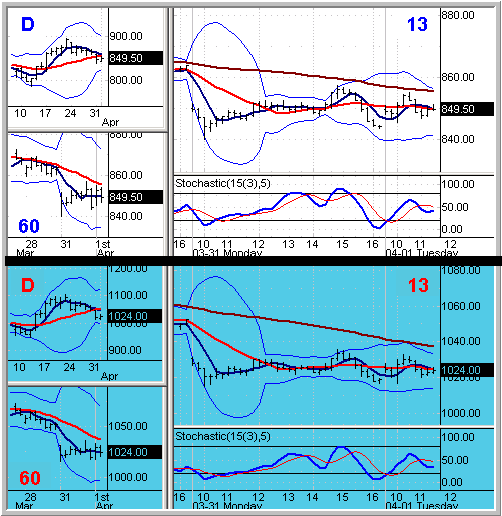How To Trade The Changing Market Rhythm
The hourly downtrend continues to
rule both major markets as we head to midday, with early trades largely of the
scalp variety. Given the strength of the
hourly downtrend, which was fully evident in yesterday’s late-day trade (was
that 3-minute trigger off the 60 pretty or what?), I’ve been in my “TUB”
(Trust Until Broken) mode, opting for short triggers off the hourly, and
passing on longs until the hourly wind turns to the north.Â
In light of recent market rhythms, I thought it might be helpful to comment a
bit on trade management and observations during recent weeks. Additionally, I
received a call last night from an individual that was asking me whether the
“favorite” trade entries included in the
video and
online course would still work in these days where it seems the vast
majority of traders are getting whipsawed left and right. (In fact, I’ve
heard more “grumbling” over the last few weeks from traders than I’ve heard in
the last several years, but I digress.)
In responding, let’s first ask ourselves whether the recent market is really
that much different than a normal market, however one might define “normal.” I
would say not at all. What I would say, however, is that the market has
alternated between rhythms of varying timeframes with a bit more frequency, and
that the emotion behind some of the moves, whether they be two-minute or hourly
surges, has been exacerbated at times. Yet the setups and triggers are working
just fine, thank you.
So why all the industry grumbling and almost comedic “keep it light” mantra,
which even I’ve preached at times? I think part of the reason is the extent
to which the rhythms have changed. The setups still work wonderfully, yet as
I’ve mentioned in recent columns, the market seems to be in one of its better
“survival of the fittest” modes that I’ve seen in a few years, a mode which
requires constant adaptation, or a keen awareness when to sit out.
For example, using our preferred timeframes, the 13-minute trend helped lead the
100-point S&P rally a few weeks ago. Yet for much of the past week, despite the
50-point retracement (much of which occurred during untradable overnight hours),
the rhythm has been highly conducive to one- or two-minute trades. Dramatically
different rhythms over a very short period of time.
Those that sat through my sequence of 100 trades in the weeklong seminar a few
weeks ago, know that I frequently trade a scalp account (Minis) and a 13-minute
account (SPYs). I do so because I recognize that the market will alternate
between 1-minute trends (aka “chop” on the larger timeframes) and longer trends.
In essence, it provides instant timing diversification, not to mention “skill
diversification” when I stink it up on one timeframe or the other. And yes,
despite a very strong daily win/loss ratio in March, there was one day where I
stunk it up on both timeframes.
Yet there are clearly days when the one-minute trend will rule in a market that
goes nowhere, as has been the case thus far this morning, while other days the
13-minute trend will rule the roost. And given the start-stop-start rhythm of
recent days that is analogous to teaching a teenager to drive a standard shift,
the market is simply reminding us yet again that rhythms will always change,
sometimes as frequently as the Red Sox bullpen, and we simply need to stay on
our toes to recognize which rhythm is in play and trade accordingly to avoid
those ninth-inning collapses. I’ve personally found that trying to compensate
for the differences with varied accounts can help, so long as it doesn’t dilute
one’s focus from one’s bread and butter.
ES (S&P)Â Â Â Â Â
Tuesday April 1, 2003 11:30 AM ET       NQ
(Nasdaq)

Moving Avg Legend:
5MA
15MA 60-Min 15MA
See
School and
Video for Setups and Methodologies
Charts ©
2002 Quote LLC
Good Trading!
Â
Â
